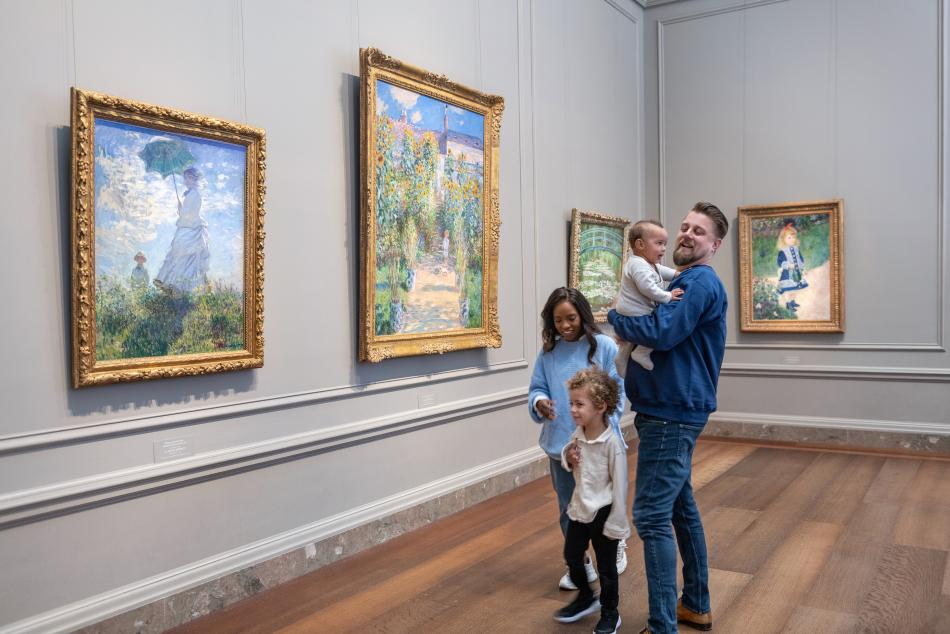Dutch Paintings of the Seventeenth Century: Portrait of a Woman Aged Sixty, 1633
Publication History
Published online

Entry
Although the name of the sitter in this impressive portrait is not known, Hals has inscribed her age, sixty, and the date of the painting, 1633, in the background on the left. The small Bible or prayer book she holds in her right hand and her conservative black costume with its white millstone ruff collar convey a pious nature, yet Hals reveals far more about her through her face and hands than through her costume or book. With broad strokes of the brush he captures her lively, robust personality. The woman’s self-confidence is expressed in the twinkle of her eyes, in the firm grasp of her hand on the arm of the chair, and in the strong silhouette of her form against the light gray background.
This painting demonstrates the range in Hals’ brushwork for commissioned portraits of the early 1630s. At this stage of his career, projecting the three-dimensionality of the figure through strong modeling of the features was of primary importance. The form of the head is built up in planes of light that are accented with firm strokes in the highlights and shadows. The white lace cap and collar are carefully depicted, as the artist sought to project not only their detail but also their translucence. While he also articulated the design in the black jacket with great care, he indicated the folds of the skirt with comparatively free brushstrokes that suggest the flickering of light off its surface.
The woman’s pose is adapted from a portrait Hals had executed two years earlier of Cornelia Claesdr Vooght , but the differences between these paintings are as remarkable as their similarities. By intensifying his light in the Washington painting, Hals has accented the woman’s features and given her greater three-dimensional presence. He has augmented this effect by flattening the angle of her collar, shifting the position of her right hand so that it is turned more toward the viewer, and placing her in a low-backed chair to allow her form to be silhouetted against a light background. The result of these changes is that the personality of the woman in the Washington painting is projected in a remarkably forceful and direct manner.
Cornelia Claesdr Vooght was the wife of the Haarlem burgomaster Nicolaes van der Meer, whose companion portrait Hals also painted in 1631 . Following portrait conventions that had been developed by Rubens, Peter Paul, Sir in the late 1610s, Hals juxtaposed a standing man with a seated woman. The pose of Nicolaes van der Meer, who rests one hand on the back of a chair and holds his gloves with the other, offers a clue to identifying a possible pendant to the Washington painting: it may well be the Portrait of an Elderly Man in the Frick Collection , in which the figure assumes a pose similar to Van der Meer’s. The proposal that the two works are pendants, first advanced by Wilhelm Valentiner, has been a matter of some dispute. Slive argued against it in 1974, largely because he dated the Frick painting 1628–1630, and also stated that their provenances and dimensions differ (the Frick painting measures 115.6 by 91.4 centimeters). In 1989, however, he noted that neither provenance extends back before the nineteenth century. Both works have actually been reduced in size, the Frick painting along the bottom and left edges and the Washington painting on all four sides. It is possible that the original format of these paintings approached that of the Haarlem ones, which are more vertical in shape.
Stylistically, there are arguments for placing the Frick portrait in about 1633, despite the blond tonality of the painting that Slive rightly associates with Hals’ works from the late 1620s. In the Frick’s painting, as in the National Gallery of Art picture, the figure boldly faces the viewer as light firmly models his features. His costume, particularly in the shoulder and sleeve design, is similar to that in Portrait of a Man, 1633, now in the National Gallery, London. These works are also comparable stylistically, not only in the careful way in which the hair is delineated and in the broad, plain modeling of the face, but also in the bold strokes of the costume with precise additions of final details such as the black brocade pattern in the Washington portrait and the black tufts on the sleeve of the Frick painting. Both the Frick and the National Gallery of Art portraits also used similar materials: the canvases were prepared with a cream-tan ground lightly tinted with brown earth, both backgrounds were loosely painted over olive-green underpainting, and the dark gray-black paint of the final costume details has developed the same fine drying cracks in both paintings.
Finally, one may also argue for the relationship of the Washington and Frick paintings in the way each of them varies from their prototype in the Haarlem pair. The hierarchical, frontal images of the 1631 portraits of the burgomaster and his wife have given way to more informal poses in which the figures turn toward the viewer and communicate through their direct glances and smiling, open expressions, a suggestion, perhaps, of a different social status.
Technical Summary
The original support, a medium-weight, plain-weave fabric, has been lined with the original tacking margins trimmed. Part of the painting surface has been turned over all four stretcher edges to form a new tacking margin, reducing the height by at least 3 centimeters and the width by at least 2.5 centimeters (see text). The X-radiograph shows only faint cusping along the top and left edges. Above the book at the juncture of the dress and arm is a large repaired hole and adjacent vertical tear.
Paint is applied over a thin, cream-tan ground as a fluid paste, with impasto in thicker passages such as the brocade and book. The face and black dress are freely painted with wet-into-wet handling, and brushstrokes in the skirt and hands are left unblended. The black brocade pattern and final touches in the lace, ruff, and cap, all added in a final painting stage, create an impression of precision and restraint. Adjustments to the silhouette of the black drapery are visible to the naked eye. A cluster of small losses is found in the upper right corner, along with scattered small losses in the background and drapery, and a linear diagonal loss that passes through the proper left thumb. In 2008 the painting was treated to remove discolored varnish and overpaint. [1]
[1] During this treatment the painting was analyzed by the NGA Scientific Research department using microscopic examination of cross-sections (see notes dated August 21, 2008, in NGA Conservation department files).



 Photo: Margareta Svensson, Frans Hals Museum, Haarlem
Photo: Margareta Svensson, Frans Hals Museum, Haarlem
 Photo: Margareta Svensson, Frans Hals Museum, Haarlem
Photo: Margareta Svensson, Frans Hals Museum, Haarlem
 Frick Collection, New York
Frick Collection, New York